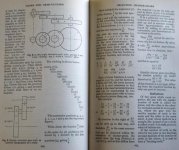enginebill
Stainless
- Joined
- Feb 17, 2005
- Location
- Plymouth Meeting PA
I had to make some metric tubing nuts for an antique French engine and none of my lathes has metric threading. Luckily my L Robbins lathe has loose change gears so I can play with ratios to get what I need. I had to cut a 1.5 mm pitch and the diameter was not a standard size. 1.5 mm equals 16.932 threads per inch which is what I was shooting for but of course the standard change gears would not do that and I do not have room for a 100/120 tooth gear set.
I figured that I could use a 72 tooth gear which I had on the 4 tpi lead screw and I would need a 17 tooth gear on the stud, which I did not have. That ratio would give me 16.941 tpi which is within 99.9 percent of what I needed which I thought would work fine. Then I go and model a 17 tooth 10DP gear in Fusion 360 and send it to my 3D printer and print out the gear that I need. It worked out great. I can also do 1.75 mm and 2 mm with that same 17 tooth gear.
I figured that I could use a 72 tooth gear which I had on the 4 tpi lead screw and I would need a 17 tooth gear on the stud, which I did not have. That ratio would give me 16.941 tpi which is within 99.9 percent of what I needed which I thought would work fine. Then I go and model a 17 tooth 10DP gear in Fusion 360 and send it to my 3D printer and print out the gear that I need. It worked out great. I can also do 1.75 mm and 2 mm with that same 17 tooth gear.






